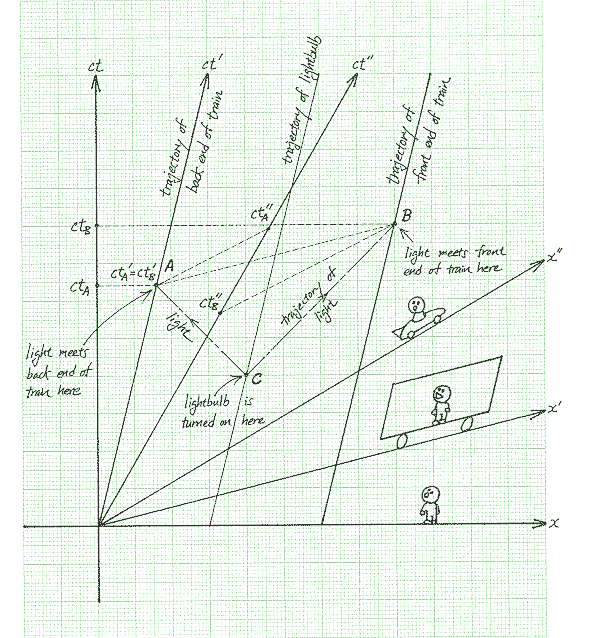

|
College of Science Physics Dept Tatsu Takeuchi Special Relativity Lecture Notes |
 1
2
3
4
5
6
7
8
9
10
11
12
13
14
15
16
17
1
2
3
4
5
6
7
8
9
10
11
12
13
14
15
16
17

9. The Concept of SimultaneityAs you can guess from the equations for the Lorentz transformation, the concept of time becomes a relative concept since we no longer have the simple relation t=t'. What we actually mean here is that the concept of simultaneity will depend on which frame you are in. This is a simple consequence of the fact that the speed of light is the same no matter which inertial frame you are in. Consider a moving train with a light bulb in the middle. If you turn the light bulb on, light will travel both toward the front of the train and also toward the back of the train with speed c=3×108m/sec. From the point of view of the observer riding on the train, the distances from the light bulb to the front and back ends of the train are the same so the light will reach both ends at the same time . However, from the point of view of the person on the ground, the front of the train is moving away from the light coming toward it while the back of the train is moving closer to the light coming toward it. This means that the distance covered by light going forward will be longer than the light going backwards. And since the speed of light is c in both directions for the observer on the ground also, the light will reach the back of the train before it reaches the front of the train.
The chronological order in which the light reaches the ends of the train will depend on the observer 
What I am saying is that 2 events that seem to have happened at the same time for the observer on train do not happen at the same time for the observer on the ground. In fact, from the point of view of another observer moving faster than the train, like the observer in the sports car above, the light reaches the back of the train after it reaches the front of the train since in that observer's frame, it is the back of the train that is moving away from the light and the front of the train that is moving toward it. So the concept of before and after actually depends on the observer. In order to clarify what we are trying to say here, please look at the spacetime diagram below. Light from the lightbulb reaches the back end of the train at A, while it reaches the front end of the train at B. All observers are observing the same two events A and B. The spacetime points at which they occur are frame independent. However, the chronological order of the events are frame dependent:

|